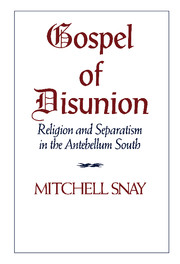Book contents
- Frontmatter
- Contents
- Acknowledgments
- Introduction: Religion and the search for Southern distinctivenes
- PART ONE RELIGION AND SECTIONAL POLITICS
- PART TWO RELIGION AND SLAVERY
- PART THREE RELIGION AND SEPARATISM
- Conclusion: Religion, the origins of Southern nationalism, and the coming of the Civil War
- Bibliography
- Index
Conclusion: Religion, the origins of Southern nationalism, and the coming of the Civil War
Published online by Cambridge University Press: 07 September 2010
- Frontmatter
- Contents
- Acknowledgments
- Introduction: Religion and the search for Southern distinctivenes
- PART ONE RELIGION AND SECTIONAL POLITICS
- PART TWO RELIGION AND SLAVERY
- PART THREE RELIGION AND SEPARATISM
- Conclusion: Religion, the origins of Southern nationalism, and the coming of the Civil War
- Bibliography
- Index
Summary
The men who helped inaugurate Jefferson Davis as the first president of the Confederacy in February 1861 personified the different ways Southerners came to secession. First and foremost were the politicians. Those who assembled in Montgomergy represented the various political paths that converged on the road to disunion. William L. Yancey, who had introduced Davis to a welcoming throng the night before, was a radical fire–eater as was the South Carolinian Robert Barnwell Rhett, who escorted the new Confederate president up the steps of the capitol. Davis himself, though not as radical as Yancey or Rhett, was a staunch defender of Southern rights. Two Georgians represented a more moderate and halting approach to disunion. Howell Cobb, who administered the oath of office to Davis, was a late convert to Southern nationalism. A supporter of the Union party in the early 1850s, Cobb had but recently joined the Georgia secessionists. Alexander Stephens, the first and only vicepresident of the Confederacy, was a former Whig who only a few months before had opposed separate state secession.
The Rev. Basil Manly represented another course that led down the road to disunion. His presence and prayer at the inauguration of Jefferson Davis symbolically recognized the role that religion played in preparing Southerners for separate nationhood. Beginning in the early 1830s, religious discourse and institutions strengthened the sectionalization of Southern culture and politics.
- Type
- Chapter
- Information
- Gospel of DisunionReligion and Separatism in the Antebellum South, pp. 211 - 218Publisher: Cambridge University PressPrint publication year: 1993



